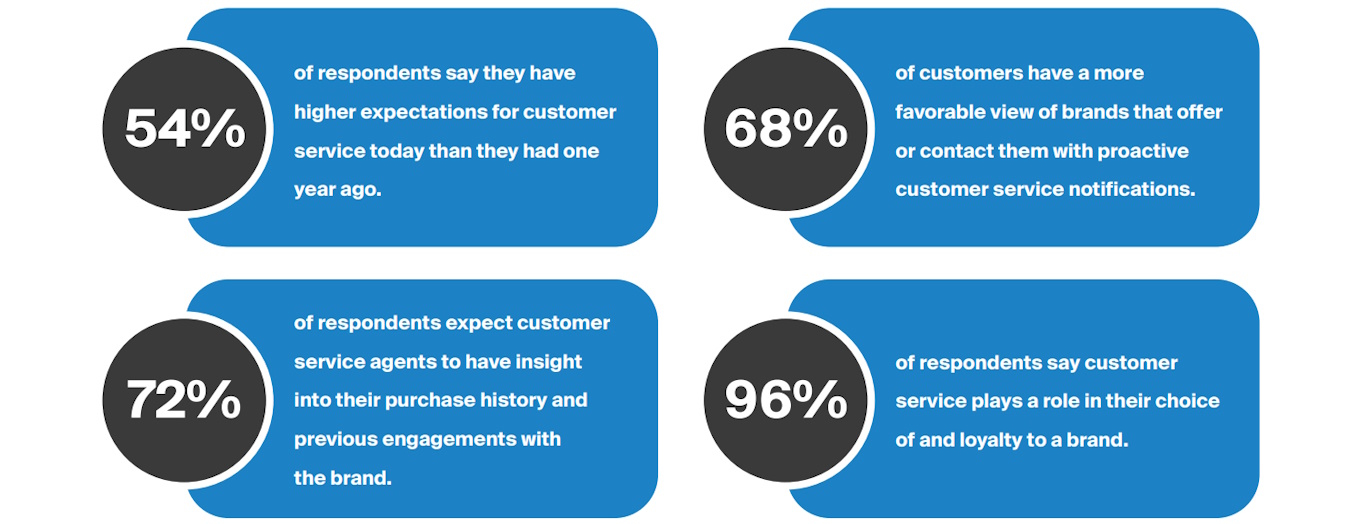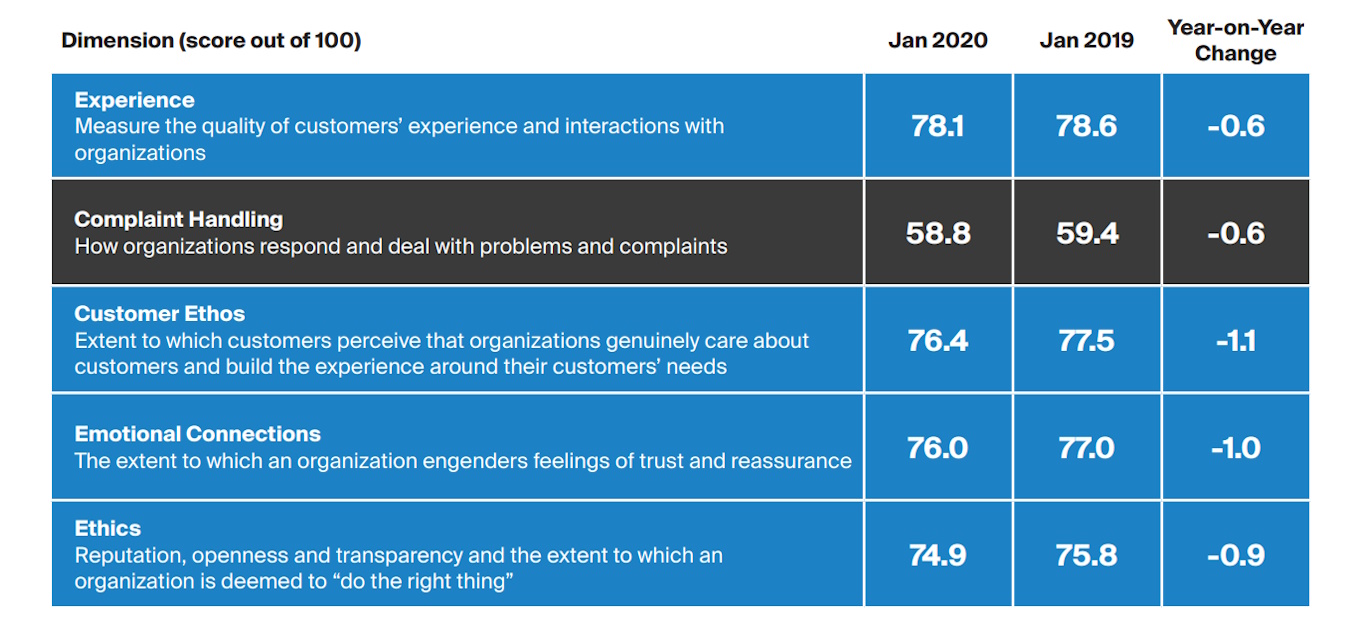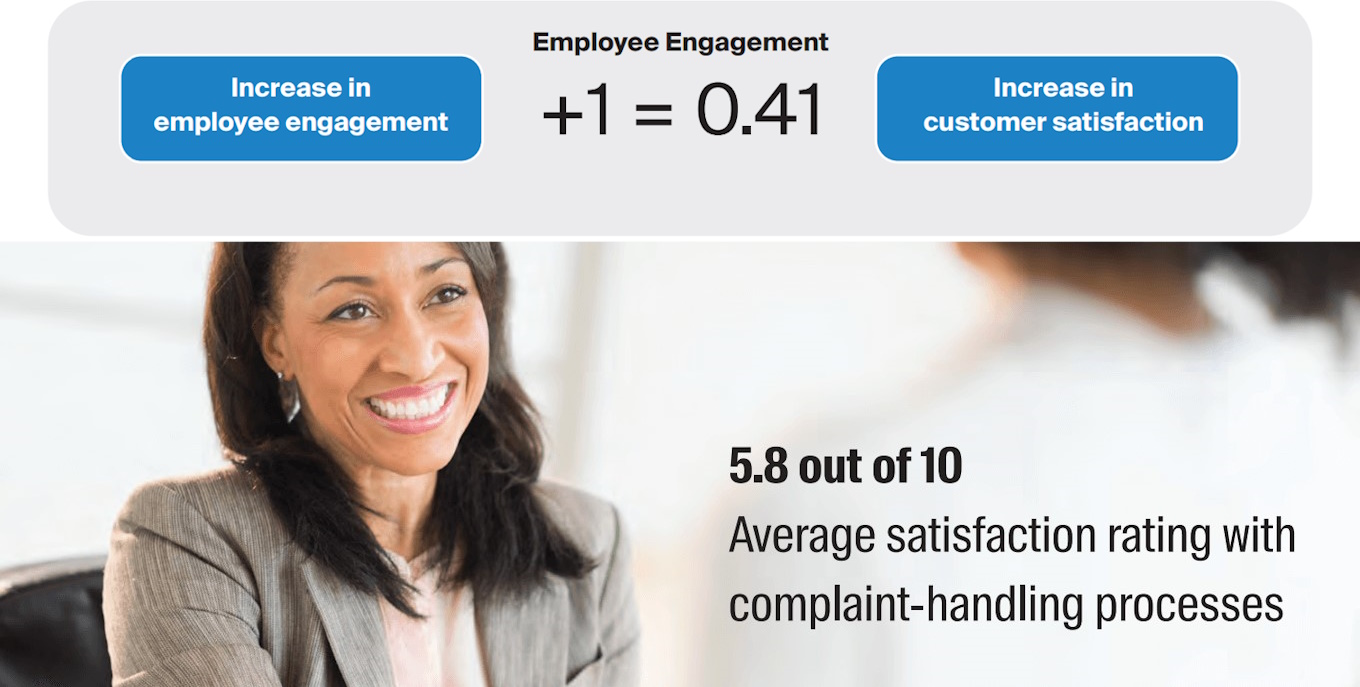Featured in this post
How To Optimise Your Complaint Handling Process for Customer Service Excellence
How To Optimise Your Complaint Handling Process for Customer Service Excellence
1 Jun 2023
 Aptean Staff Writer
Aptean Staff Writer 
Customer service isn’t easy. But, without happy customers, it’s impossible to grow your business.
Because of this, many financial services organisations are putting customer service at the very heart of their business. While feedback and complaints play a vital role in driving product, service and process improvement, many businesses still struggle to harness the insight that can be derived from these two crucial aspects of customer service.
Changing the face of customer service is all about aligning the day-to-day, customer-facing tasks with executive and customer priorities. It’s important to understand the connection between complaint management, customer experience (CX) excellence and organisational performance, and a failure to recognise the interconnectivity of customer service with every other department, leads to inevitable gaps within your business.
This blog provides valuable complaints and feedback insight from the customers’ perspective to help you optimise the five key stages in your complaint handling procedure—securing better outcomes for your business and customers alike.
We also shine a light on how the right complaint management solution can improve customer interactions, accelerate case and complaint resolutions, and generate actionable insights to boost your overall business performance.
What Do Customers Care About?
Companies that succeed often follow the same simple rule: the customer always comes first.
Customer service shouldn’t be an isolated department, but a key focus area across every aspect of your business. If all your employees make decisions with a customer-first mentality, you can’t help but improve the customer experience. And, make no mistake, customers expect nothing but the best.
A Microsoft study discovered that as technology continues to drive the customer experience, expectations are rising and show no sign of stopping. The reported numbers below are simply too high to ignore. Instead, they can and should be used to motivate executives and employees alike to put customer service excellence at the heart of your business. The payoff will be worth it if your organisation seizes the opportunity.

The Institute of Customer Service (ICS) studied customers’ behavioural patterns over 12 months. The chart below highlights what customers value as most important when evaluating an organisation—a shortlist of what they consider when forming an opinion of a company.
The research shows that many customer service functions have key roles to play suggesting that a cultural and procedural focus on service excellence is needed to secure favourable outcomes. This is evidenced by the ICS finding that the highest performing organisations for customer satisfaction tend to be highly rated across all dimensions of customer satisfaction.
Complaint handling—how an organisation manages a customer complaint from start to finish—is a critical aspect of this company-wide customer journey. The businesses that handle complaints most effectively tend to retain their customers, have clear communications (both internally and externally) and operate more efficiently.

Businesses that address complaints in a timely, genuine manner are setting themselves up for success. Conversely, firms who don’t take the complaint handling process seriously are preparing themselves for failure. The Microsoft study went on to indicate 58% of global respondents have stopped doing business with a brand due to a poor customer service experience, so it’s clearly not a risk worth taking.
It’s important to remember: if a customer complains, it means they care. That's why you must take what each of your customers has to say seriously and communicate clearly every step of the resolution. In order to do this, you'll need a robust procedure that is founded on the principles of good complaint handling, as well as the right complaint management system to help you manage this process efficiently and improve customer service outcomes.
Now that we have a grounding in why all encompassing customer service is so crucial, let's delve into the five stages of a good complaint handling process—and how complaints management excellence becomes a crucial factor in driving increased revenue for your organisation.

1. The Capture Stage
Any complaint handling procedure is complicated—a lot must happen for a dissatisfied customer to feel they’ve achieved a definite sense of resolution. Beginning with the Capture Stage, a complaint typically moves through five stages in its journey with each step invaluable to ensuring the customer has a positive experience with your enterprise, paving the way for increased customer loyalty and assured future business.
When it comes to this first stop on the journey, offering a choice of communications channels is critical. Customers like to use their preferred communications channel (email, telephone, social media, etc.) to complain—therefore you must offer an omnichannel experience to cover all the bases.
Customers want to feel like it’s easy to raise issues with the companies they interact with; that the company empathetically understands their problems and their needs from the outset, so they can begin to trust that you will investigate their issue fairly and promptly. Therefore, offering them a variety of complaints channels helps build this trust and reassurance from the outset.
Selecting which channels to offer your customers should not solely be about cost-to-service. There’s a risk involved in driving customers to a channel that may not be their first or even second preference and so it’s vital to grant your customers that choice, letting them decide what works best for them.
Ensuring this initial stage in your complaint handling procedure is both convenient and accessible for your customers will not only improve their experience, but lead to better outcomes for your business, as customer's who can communicate with their preferred channel tend to be more satisfied than those who cannot.
A simple way to ensure desirable outcomes all around in this first stage is to look to technology. In terms of aligning executive priorities with those of frontline complaint handlers, it’s valuable to consider the return on investment (ROI) involved in a complaint management solution. By providing customers with self-serve complaint communication options, the phone will undoubtedly ring less, meaning that there’s no need to dedicate an entire team to a call-centre operation, for example.
By utilising the tools within a complaint management solution, you can grant your customers the power to reach out in the most convenient manner to them and seamlessly record all those first-points-of-contact. This eliminates the need to re-key information and optimises your staff resource, saving you time, effort and money—all while improving your customer experience.

2. The Investigation Stage
The next stage in a good complaint handling procedure is both extremely busy and vitally important—therefore setting your teams up for success with the right processes and tools is crucial. Even if your employees are busy investigating a complaint, in this stage customers need to be updated and have their expectations managed. They often understand that complex issues take time to resolve, but they need to know that your organisation is doing what it can to address the issue. They also want to know that you’re considering their particular set of circumstances, including taking into account any customer vulnerability factors.
Much of the complaints heavy-lifting is performed at this stage of the process, so implementing technology here can help streamline and improve your operations. For example, in this stage, it’s important to align employees’ capabilities by moderating some of the low-value activities of case professionals, freeing them up to pursue more considered, value-add activities. With the right complaint management solution, regular communication with the customer can be automated and delivered at the right time, meaning less onus on the customer to chase-up outstanding issues and more time for case handlers to progress the resolution.
In addition, the best complaint handling software can help detect signs of customer vulnerability, empowering your case handlers and providing them with all the necessary data they need to progress through the investigation stage and prioritise customer experience in a nuanced manner.
This stage of the journey also provides a unique opportunity to not only nurture customer loyalty but to create valuable customer advocates in the process. With 74% of consumers identifying word of mouth as a key influence in their purchasing decisions, never has customer advocacy been more important.
By complaining, a customer is presenting you with an opportunity to earn back their business and their trust. This stage gives you a real opportunity to show customers that you know them and their history with you, but also that you really understand them. It’s about their needs, their circumstances and their limitations. Yes, there will be frameworks and guidelines in place to help shape outcomes, and rightly so, and you’ll want a complaint management solution that can manage the complexity involved with case management—the capture, storing and sharing of evidence internally and with arbitrators.
But, listening to and understanding a customer may mean going outside of those guidelines. Your employees, with the right governance, should be empowered to do so. It’s only then that you can hope to start the transformation from unsatisfied customer to loyal customer advocate.

3. The Resolution Stage
This is undoubtedly the most critical stage of your complaint handling process. What happens in the resolution stage can make or break the future of your customer’s relationship with your company. Truly understanding your customer’s complaint and coming to a resolution that promotes trust and transparency is the key to success.
When a customer raises a complaint, they are looking for a resolution that seems right (to them) and one they can understand. We can see that 62% of customers are not happy with the explanation they received about the outcome of their complaint. If they don’t understand why a decision has been made, it’s highly unlikely they’ll feel that it’s right and fair.
Complaint handlers must showcase their emotional intelligence in these situations. When hiring complaint handlers you should make this attribute a priority when it comes to staffing the frontline. More important than product or process knowledge is the ability to display empathy, listening carefully and showing authentic interest in the complainant’s predicament. Your complaint handlers are at the forefront of the customer experience journey and so it’s vital that they have those qualities and the ability to communicate clearly and effectively.
When a customer complains, you want to make them comfortable not only with the outcome, but throughout the entire process. This starts with the complaint handler.
Risk reduction is key. In the resolution stage of a good complaint handling procedure, you want to create as few risks as possible. This means mitigating adverse outcomes associated with the customer experience. By employing an advanced complaint management solution, like Aptean Respond, you’re eliminating some of the common potential danger zones—miscommunication, delayed communication, undesirable outcome, customer defection.
Risk reduction is all about ensuring quality and plays an essential part in the entire complaint resolution process. As such, a thoughtful, thorough and tenacious approach to quality is key to improving customer outcomes.

4. The Fulfilment Stage
In terms of case fulfilment, keeping your promises is crucial to driving up satisfaction. By delivering a positive complaint experience, you’re much more likely to create a customer advocate. 96% of companies believe that complainants can be turned into advocates, but only 26% of customers are satisfied with their complaint experience. While it’s almost impossible to get 100% customer satisfaction, there remains a massive opportunity to get things right more often.
Too often, the fulfilment process is a manual activity with holes in it as colleagues outside the case-handling function invariably complete it. The handoff is often manual and assumed to have taken place, potentially causing reputational damage. To maintain excellence throughout your complaint handling process, you should consider the benefit of automating that handoff via a robust complaint management solution—not only is it operationally more efficient, but you can ensure your fulfilment promises have been kept.
Complaint handling and customer recovery are critical measures for customer satisfaction. How a customer scores these measures depends on their experience, their emotions and your ethics. You may also want to consider a progressive approach to how you measure the performance of your case handling professionals, incorporating satisfaction scores directly from customers.
Automated survey capabilities within a complaint management solution allow you to do this based on a specific case handler or a case-by-case basis. This represents a direct link between the case handler and the customer’s perception of them, helping your employees to feel understood and that their performance is being fairly evaluated.

5. The Insight Stage
Now that you've captured, investigated, resolved and fulfilled a complaint, there’s still one more stage to go in your complaints handling process: the Insight Stage.
Good complaint management is key to combatting dissatisfaction, but it’s not a guarantee of increased satisfaction. The UK Customer Satisfaction Index identified that it’s only complaints achieving a satisfaction rating of 9 or 10 (out of 10) that lead to a higher-than-average overall satisfaction. This means over 70% of complaints are likely to result in lower-than-average customer satisfaction. That means that complaint excellence matters when looking to improve customer satisfaction.
While productivity, channel preference and addressing the root cause of complaints are important when looking at improving customer satisfaction, it’s also worth considering employee engagement. You need your customers to feel you’re capable of fixing things, reducing problems to make it easier for them to do business with you.
That sentiment needs to be felt through the technology you offer and your processes, but also through the experience they have with your employees. And your employee needs to be engaged to deliver a high level of expertise good service.
Moreover, the Institute of Customer Service found compelling evidence that high levels of employee engagement lead to stronger customer satisfaction, loyalty and business performance. A comparison of organisations’ customer satisfaction and employee engagement scores suggests that a one-point increase in employee engagement is likely to give a 0.41-point increase in customer satisfaction. And Forbes highlighted that 73% of companies with above-average customer experience perform better financially than their competitors.
So, taking all of this into consideration, the final stage of your complaint handling process should be to gather insights that can help identify areas for improvement—for staff engagement, customer experience and business outcomes—and create both a customer-centric company culture and a cycle of continuous improvement. Again, technology can play an active role here by collecting and consolidating all of your complaints handling data in one location, empowering you to analyse the process and make measurable enhancements.
Achieve Customer Service Excellence
Customer experience is impacted by all departments within your enterprise and should therefore shape products, processes and organisational culture. This is why achieving customer service excellence should be a topmost priority for your business.
By successfully managing complaints, you have the potential to create not only brand loyalists, but brand advocates. They offer unsolicited praise of your business, sending other customers your way. And, the best part of the unsolicited praise—it’s free. The only way to experience this kind of brand loyalty is by taking care of the customers you do have, treating them and their opinions with respect and empathy, and delivering on your promises.
There is an ever-increasing conversation around the importance of the customer experience and the need to provide an authentic, transparent, trustworthy and differentiating experience for customers. Many organisations want to drive further customer experience improvements but struggle to get senior leadership support. It’s safe to say that executive priorities are often centred on growth, cost reduction and risk reduction. But increased customer satisfaction is proven to lead to more revenue growth; excellent complaint handling inevitably leads to increased customer satisfaction.
As the key to overall business growth and success, it’s never been more critical to invest in achieving customer service excellence. And as part of that, you need a comprehensive and optimised complaint handling procedure.
A complaint professional does more than only manage complaints; it’s their responsibility to drive up customer satisfaction and help grow your business. It’s hard to do, but it’s no longer hard to measure. With the right training, staff and tools in place, you can quantify the impact of making your business customer satisfaction driven, with complaints excellence a crucial factor in driving increased revenue for your organisation.
Implementing the right complaint management system can help you automate many stages of the complaint handling process, adhere to regulatory requirements and improve data visibility throughout—ultimately helping you streamline operations, enhance customer experience and improve business outcomes.
Aptean Respond is a solution that puts customer satisfaction at the forefront, and our team is committed to enabling and ensuring your organisation’s success. If you’d like to learn more about how you can position complaint handling excellence at the heart of your business, contact us today or request a demo.
Achieving Customer Service Excellence with Aptean Respond
In this eBook, you will learn about the success organisations like yours have had when using Aptean Respond for their complaint and case management.



